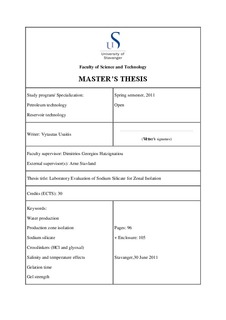| dc.description.abstract | A common problem for maturing oil fields is excessive water production. Ultimate oil recovery could be increased considerably by implementing an appropriate water production management. Solutions for managing excess water production may include the use of smart-well completions, downhole water separation and disposal, as well as mechanical and chemical means of delaying, reducing or shutting off excess water production. As such, an in-depth placement of blocking agent can reduce water influx in the borehole and contribute to lower water cut and, thus, extend the lifetime of an oil production well.
Low impact on the environment revitalized sodium silicate systems in the oil industry for zonal isolation. This thesis focuses on the laboratory evaluation of sodium silicate as zonal isolation chemical for water control applications. Sodium silicate solution forms gel when pH is reduced below 11. For pH control, two different crosslinkers (HCl and glyoxal) were used in this work. Gelation time and strength of the formed gel play an important role in designing successful water shutoff treatment in a field trial. Gelation time is defined as the time required for the gel to become rigid. Gelation codes are introduced to distinguish the macroscopic changes of the gel.
This thesis also discusses the parameters affecting gelation time for gels formed by crosslinking sodium silicate with glyoxal. These parameters are: sodium silicate and glyoxal concentrations, temperature, salinity and presence of divalent ions in the makeup water. It is shown that gelation time is reduced for increased sodium silicate and glyoxal concentrations. NaCl and CaCl2 act as catalysts and decrease gelation time. A more rapid gelation was observed at higher temperatures.
AcoustoSizer from Colloidal Dynamics was tested to determine particle size distribution for sodium silicate crosslinked with HCl. Results showed that the AcoustoSizer underestimates particle diameter for polymerizing particles and, therefore, further testing was abandoned.
Finally, gel strength is studied and expressed as the applied pressure drop required to compromise the gel’s integrity in a testing tube. Sodium silicate gels’ strength, formed using various crosslinker (HCl and glyoxal) concentrations, is tested at different temperatures.
Pressure tests have shown that stronger gels could be created using higher glyoxal concentrations. An increase in sodium silicate or HCl concentrations only slightly increases gel strength. | no_NO |
